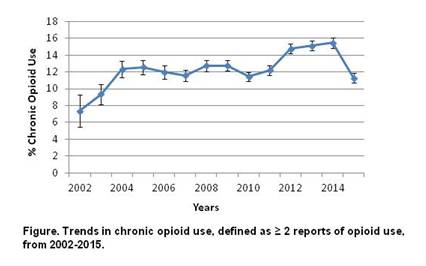Session Information
Session Type: ACR Concurrent Abstract Session
Session Time: 2:30PM-4:00PM
Background/Purpose: The opioid epidemic is a major public health concern, requiring urgent action. However, little is known about chronic opioid use among individuals with RA. We examined trends in chronic opioid use in RA patients from 2002-2015 and identified clinical factors predicting chronic opioid use.
Methods: RA patients were identified from a large multicenter US registry. Opioid use was ascertained from surveys obtained at routine clinical visits, as often as once every 3 months. The primary outcome was chronic opioid use, defined as any opioid use reported during at least 2 consecutive study visits. Cox Proportional Hazards regression models were performed to identify associations between patient characteristics and incident chronic opioid use. Subgroup analyses were performed among RA patients with no pain at study entry and RA patients with at least 1 documentation of opioid use from 2002-2015.
Results: Among 31,993 individuals with data on opioid use from at least 2 visits, chronic opioid use increased from 7.4% in 2002 to 15.5% in 2014 and decreased to 11.3% in 2015 (Figure). Among the 25,054 individuals who were not taking opioids at baseline, longer disease duration, higher RA disease activity, worse disability, more pain, biologic DMARD use, corticosteroid use and antidepressant use were significantly associated with increased risk of chronic opioid use (Table). Asian race and a greater number of past DMARDs were associated with lower risk of chronic opioid use. Similar results were observed in a sensitivity analysis with chronic opioid use defined as at least 3 consecutive reports of opioid use. In a subgroup analysis of RA patients with no pain at baseline (N = 6,580), being female (HR 1.37, 95% CI 1.07-1.75) and being on both Medicare and Medicaid (HR 2.03, 95% CI 1.00-4.12) were associated with chronic opioid use, whereas RA disease duration and disability were no longer associated with chronic opioid use. In a subgroup analysis of RA patients with at least 1 report of opioid use during the study period (N = 6,758), the risk of progression to chronic opioid use was most strongly predicted by high disease activity (HR 2.56, 95% CI 2.02-3.24) and high pain (HR 1.36, 95% CI 1.14-1.64).
Conclusion: Among individuals with RA, chronic opioid use doubled from 2002 to 2014 but did not increase in 2015. Worse RA disease characteristics predicted increased risk of chronic opioid use, whereas a higher number of past DMARDs was associated with a lower risk of chronic opioid use. Future studies are needed to determine whether aggressive treatment of inflammatory disease leads to a decrease in chronic opioid use.
|
Table. Multivariable, time-updated, adjusted hazards ratios for the association between patient characteristics and incident chronic opioid use among individuals with RA, from 2002-2015 (N = 25,054). |
|
|
Patient Characteristic |
Multivariable Adjusted Hazards Ratio (95% CI) |
|
Age |
1.00 (0.99-1.00) |
|
Sex |
|
|
Male |
Ref |
|
Female |
1.04 (0.96-1.13) |
|
Race |
|
|
White |
Ref |
|
Hispanic |
0.97 (0.79-1.18) |
|
Black |
1.01 (0.84-1.21) |
|
Asian |
0.46 (0.33-0.66) |
|
Other |
0.99 (0.79-1.25) |
|
Insurance |
|
|
Private |
Ref |
|
Medicaid |
1.16 (0.98-1.37) |
|
Medicare |
1.14 (1.00-1.30) |
|
Both Medicaid and Medicare |
1.14 (0.87-1.49) |
|
None |
0.92 (0.65-1.29) |
|
RA duration |
|
|
<5 years |
Ref |
|
5-10 years |
0.98 (0.88-1.10) |
|
>10 years |
1.15 (1.04-1.28) |
|
CDAI category |
|
|
Remission (less than or equal to 2.8) |
Ref |
|
Low (>2.8-10) |
1.75 (1.51-2.02) |
|
Moderate (>10-22) |
2.73 (2.30-3.24) |
|
High (>22) |
3.79 (3.13-4.59) |
|
HAQ Disability Index |
|
|
Less than or equal to 0.5 |
Ref |
|
0.5-1.0 |
1.27 (1.15-1.40) |
|
> 1.0 |
1.18 (1.03-1.36) |
|
Pain |
|
|
None |
Ref |
|
Low |
1.73 (1.50-1.99) |
|
Moderate |
2.10 (1.76-2.51) |
|
High |
2.40 (2.01-2.88) |
|
Number of previous DMARDs used |
0.85 (0.82-0.88) |
|
Biologic DMARD use |
1.45 (1.32-1.59) |
|
Corticosteroid use |
1.28 (1.17-1.39) |
|
Antidepressant use |
1.66 (1.53-1.81) |
To cite this abstract in AMA style:
Lee YC, Kremer J, Guan H, Greenberg JD, Solomon DH. Trends and Predictors of Chronic Opioid Use in Individuals with RA [abstract]. Arthritis Rheumatol. 2017; 69 (suppl 10). https://acrabstracts.org/abstract/trends-and-predictors-of-chronic-opioid-use-in-individuals-with-ra/. Accessed .« Back to 2017 ACR/ARHP Annual Meeting
ACR Meeting Abstracts - https://acrabstracts.org/abstract/trends-and-predictors-of-chronic-opioid-use-in-individuals-with-ra/

